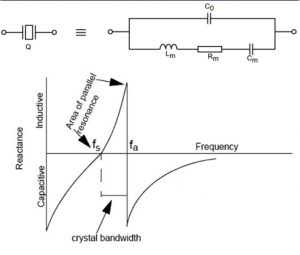The frequency deviations of quartz crystals-What is Xtal MHz frequency?
The frequency deviations of quartz crystals – What is Xtal MHz frequency?
In a previous part of this series, we spoke about some metrics used to evaluate quartz crystals’ frequency fluctuations. From this point on, these devices will undergo a more in-depth analysis every step of the way. Let’s start by looking at a typical crystal’s reactance versus frequency curve. In this section, we will investigate about what is Xtal MHz frequency?
Two unique oscillator topologies and how the circuit structure imposes a specific frequency on the crystal so that it may oscillate at that rate. We will get the opportunity to examine the definitions of parallel and series crystals, two notions that might be puzzling to anyone unfamiliar with the language.
Crystals Have Two Resonant Frequencies:
To better understand what is Xtal MHz frequency? Let’s imagine that the crystal is flawless and that Rm has no effect on the situation. In the crystal electrical model’s bottom branch, Lm and Cm may be sequentially one after the other.

When series resonance occurs, the impedances of Lm and Cm cancel out and become equivalent to one another. When the impedance of the lower branch goes to zero, the impedance of the crystal as a whole also goes to zero. This number is the one that corresponds to the series resonant frequency of the crystal, which is represented by the symbol fs in Figure 2. To refresh your memory, the frequency in question is unaffected by Co.
The behavior of the crystal changes from resistive to inductive at fs, which occurs when the reactance of Lm is greater than that of Cm. Its reactance, which is the series combination of Lm and Cm, increases with frequency, and there is a frequency at which it is equivalent to the reactance of the crystal model’s Co. At this stage, we have a parallel LC in resonance, and the overall impedance of the crystal is becoming closer and closer to infinity. The frequency denoted by the symbol fa is the anti-resonant frequency. This frequency is usually higher when measured compared to the series resonant frequency.
At What Frequency Is the Crystal Going to Oscillate?
Crystals vibrate in two separate ways, as was recently found by us. At both fs and fa, the crystal has an impedance that may be described as resistive. While the resistance of the crystal is close to zero when it operates at the fs frequency, it approaches infinity when it works at the anti-resonant frequency. When designing a circuit for an oscillator, it is necessary to determine the frequency at which the crystal will vibrate.
The topology of the oscillator determines the answer. At the oscillation frequency, the oscillator loop gain has to be more than one, and its phase shift needs to be an integral multiple of 2. These factors will either increase or decrease the frequency of the crystal’s oscillations.
XTAL Oscillators:
Crystals are produced yearly, and it is anticipated that every electronic device now available on the market utilizes them. For digital and analog subsystems to function correctly, such as phone networks, digital clocks, and even your microwave, a dependable oscillator is required. The process of building a circuit for an XTAL oscillator is equally as critical as selecting a crystal that can keep precise timing.
It is possible to get XTALs that can function at frequencies ranging from ten to one hundred megahertz from various vendors on the market (MHz). Because of its capacity to keep accurate time in both digital and analog circuits, an oscillator is a crucial component in both types of rotations. Analog and digital circuits both employ oscillators. When dealing with frequencies in the gigahertz range, you must reevaluate your strategy and go for a computer setup with a highly stable reference oscillator. A look at some of the essential facts that you really must be aware of about “What is Xtal MHz frequency?”
What is Xtal MHz frequency?
Crystal oscillators can produce oscillations at frequencies ranging from around 40 kHz to well over 100MHz, depending on the architecture of their circuits and the amplifier they use. If you want to know more about what is Xtal MHz frequency? There are several parameters, such as the form of the crystal’s crystallographic facets that impact the crystal’s resonant qualities
There is a possibility that the crystal will have more than one resonance frequency, resulting in the production of so-called harmonics such as the second and third harmonics. It will happen if the crystal isn’t precisely parallel and uniform in thickness.
When working with a quartz crystal, it is often best to keep to the fundamental oscillation frequency of the crystal since this frequency is far more dominant than the secondary harmonics found around it. Because of the two resonant frequencies (the lowest in series and the highest in parallel), that can be achieved with an equivalent crystalline circuit, as shown in the above graphs, the circuit consists of three reactive components: two capacitors and an inductor. You can achieve the lowest resonant frequency by connecting the components in series, while you can achieve the highest frequency by connecting the components in parallel.
Conclusion:
This article helps you to learn about what is Xtal MHz frequency?” If you are in the market for a new oscillator, one of your first concerns should be ensuring that you purchase one of the greatest possible quality. When it comes to maintaining a stable frequency, one of the most crucial considerations is frequency stability. When it comes to frequency stability, a quartz crystal oscillator will always be your best choice. Utilizing a quartz oscillator may result in a multitude of positive outcomes.
